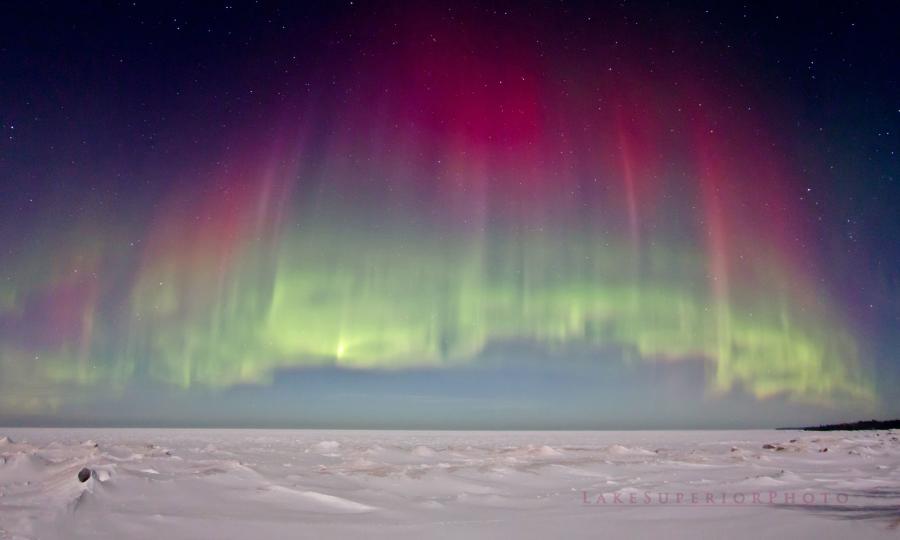In this quick Q&A, Marquette-based visual artist & owner of Lake Superior Photo Gallery answers all of our Aurora-based questions.

Q: WHEN AND HOW CAN YOU SEE THE NORTHERN LIGHTS?
A: The northern lights are driven by solar events on the sun. You can check online to view the evening's Kp index, which is an average of solar activity around the world measured in 3-hour increments on a scale of 0-9. At our latitude, a Kp 4 or greater means good odds. With a higher Kp, clear skies, and a few other favorable space weather data indicators, all you need is a good dark sky location facing north.
Q: WHERE CAN I SEE THEM IN MARQUETTE COUNTY?
A: Any time the aurora is active low on the horizon, (most common at our latitude) it is best to get away from the city lights of Marquette to a very dark sky location with an unobstructed view of the northern horizon. So basically anywhere along the lakeshore is fantastic including Little Presque Isle Beach, Wetmore Landing and the M28 turnouts. If the aurora is bright enough, Picnic Rocks, south Marquette and the Welcome Center in Harvey are also easily accessible options.
Q: HOW DO YOU PHOTOGRAPH THE NORTHERN LIGHTS?
A: As long as you understand a few basics of getting the camera out of auto mode, you can get some awesome shots of the auroras. A basic outline to follow includes A: Lens in manual B: Camera in manual C: ISO setting between 1600-3200 D: aperture as wide open as possible to let in as much light as possible (think low numbers, f1.4,2.8, etc.) E: Shutter speed as long as possible before you start picking up star movement, anywhere from 5-20 seconds. You may have to go longer if you need more light in your images. Other things you need besides your camera—a tripod to steady the shot for long exposure, cable release, and headlight so you can see when you adjust your settings or need to find the bottom of your frame in a new moon environment. That, or I offer several night sky photography workshops during the year!

Q: WHAT CAUSES THE NORTHERN LIGHTS?
A: The aurora starts with a strong solar event sending an elevated solar wind of charged particles (electrons) towards Earth. These electrons strike Earth's magnetosphere and travel along magnetic field lines towards the north and south poles where they collide with oxygen and nitrogen atoms in Earth's upper atmosphere. The atoms excite, then relax and release a photon, which is light. This is what we see as the aurora borealis. This is similar to how a neon light works.
NOTE: Different atmospheric atoms give off different colors when they are excited. Oxygen at about 60 miles up gives off the familiar yellow-green color, Oxygen at higher altitudes (about 200 miles above us) gives the all-red auroras. Ionized nitrogen produces the blue light and neutral nitrogen gives off the red-purple and the rippled edges.
Q: WHAT ADVICE WOULD YOU GIVE TO SOMEONE HOPING TO CATCH THE NORTHERN LIGHTS?
A: Maximize your potential for seeing the aurora by learning about space weather predictions from NOAA Space weather! Settle into one of Marquette’s many north-facing dark sky areas and make sure the local forecast is clear as the aurora can’t be seen when there is cloud cover. Most important data readings for determining if you can see the aurora are:
- Bz—The strength of the magnetic field, south-pointing Bz is favorable
- Ovation Model—A real-time image of the auroral oval, look for a hemispheric power of 30 or greater
- Solar Wind Speed Measurement—A 600 or greater indicates you’ll most likely be able to see the aurora
Also, be aware of the moon phases as a full moon will wash out less active auroral displays and greatly decrease the ability to see the night sky. Be patient if there is geomagnetic storming, it ebbs and flows and you can have multiple substorms in one night with visible activity varying greatly over the span of just a few minutes.
Q: WHAT DO YOU RECOMMEND TO GET GEARED U.P.?
A: As far as equipment essentials, I'd say certainly a camera, tripod with a cable release, high capacity card & back-up battery. And of course, warm clothes, a headlight & water bottle. If you're looking for resources, I'd recommend checking out sites like NOAA Spaceweather, Space Weather Live, Solar Ham, Time and Date & Stellarium.
Photos courtesy of Shawn Malone

